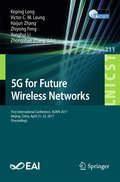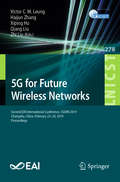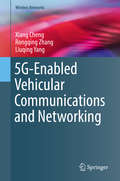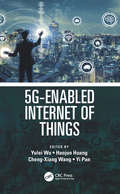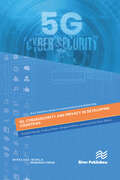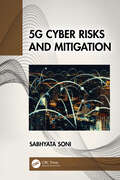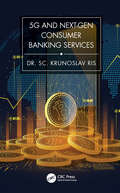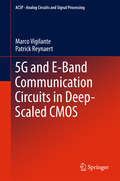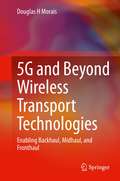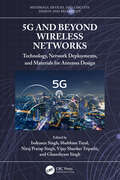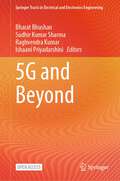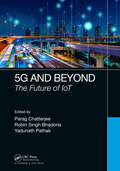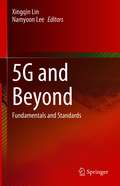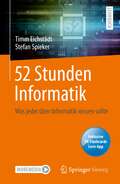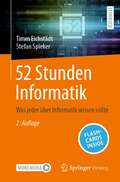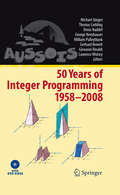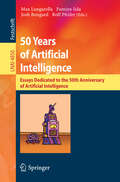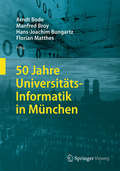- Table View
- List View
5G for Future Wireless Networks: First International Conference, 5GWN 2017, Beijing, China, April 21-23, 2017, Proceedings (Lecture Notes of the Institute for Computer Sciences, Social Informatics and Telecommunications Engineering #211)
by Keping Long Victor C.M. Leung Haijun Zhang Zhiyong Feng Yonghui Li Zhongshan ZhangThis book constitutes the proceedings of the First International Conference on 5G for Future Wireless Networks, 5GWN 2017, held in Beijing, China, in April 2017. The 64 full papers were selected from 135 submissions and present the state of the art and practical applications of 5G technologies. The exponentially growing data traffic caused by the development of mobile Internet and smart phones requires powerful networks. The fifth generation (5G) techniques are promising to meet the requirements of this explosive data traffic in future mobile communications.
5G for Future Wireless Networks: Second EAI International Conference, 5GWN 2019, Changsha, China, February 23-24, 2019, Proceedings (Lecture Notes of the Institute for Computer Sciences, Social Informatics and Telecommunications Engineering #278)
by Haijun Zhang Xiping Hu Qiang Liu Zhi Liu Victor C. LeungThis book constitutes the proceedings of the Second International Conference on 5G for Future Wireless Networks, 5GWN 2019, held in Changsa, China, in February 2019. The 13 full papers were selected from 34 submissions and present the state of the art and practical applications of 5G technologies. The papers are arranged thematically on optimization theory and applications, intelligent computing technology for 5G applications, resource allocation and management, and security and privacy in emerging 5G applications.
5G-Enabled Vehicular Communications and Networking (Wireless Networks)
by Xiang Cheng Rongqing Zhang Liuqing YangThis book investigates and reviews recent advanced techniques and important applications in vehicular communications and networking (VCN) from a novel perspective of the combination and integration of VCN and connected vehicles, which provides a significant scientific and technical support for future 5G-based VCN.5G-Enabled Vehicular Communications and Networking introduces vehicular channel characteristics, reviews current channel modeling approaches, and then provides a new generic geometry-based stochastic modeling approach for vehicle-to-everything (V2X) communications. The investigation of vehicular channel measurements and modeling provides fundamental supports for the VCN system design. Then, this book investigates VCN-vehicle combination from PHY and MAC layers, respectively. As for the PHY layer, many advanced techniques that can be effectively applied in VCN to counter the PHY challenges are introduced, including novel ICI cancellation methods, index modulated OFDM, differential spatial modulation, and energy harvesting relaying. As for the MAC layer, distributed and centralized MAC designs are analyzed and compared in terms of feasibility and availability. Specifically, distributed congestion control, D2D-enabled vehicular communications, and centralized data dissemination scheduling are elaborated, which can significantly improve the network performance in vehicular networks. Finally, considering VCN-vehicle integration, this book introduces several hot-topic applications in vehicular networks, including electric vehicles, distributed data storage, unmanned aerial vehicles, and security and privacy, which indicates the significance and development value of VCN-vehicle integration in future vehicular networks and our daily life. The primary audience for this book includes professionals and researchers working in the field of vehicular communications, intelligent transportation systems (ITS), and Internet of vehicles (IoV). Advanced level students studying electrical engineering will also find this book useful as a secondary textbook for related courses.
5G-Enabled Internet of Things
by Yi Pan Yulei Wu Cheng-Xiang Wang Haojun HuangHow the enabling technologies in 5G as an integral or as a part can seamlessly fuel the IoT revolution is still very challenging. This book presents the state-of-the-art solutions to the theoretical and practical challenges stemming from the integration of 5G enabling technologies into IoTs in support of a smart 5G-enabled IoT paradigm, in terms of network design, operation, management, optimization, privacy and security, and applications. In particular, the technical focus covers a comprehensive understanding of 5G-enabled IoT architectures, converged access networks, privacy and security, and emerging applications of 5G-eabled IoT.
5G-Enabled Internet of Things
by Yi Pan Yulei Wu Cheng-Xiang Wang Haojun HuangHow the enabling technologies in 5G as an integral or as a part can seamlessly fuel the IoT revolution is still very challenging. This book presents the state-of-the-art solutions to the theoretical and practical challenges stemming from the integration of 5G enabling technologies into IoTs in support of a smart 5G-enabled IoT paradigm, in terms of network design, operation, management, optimization, privacy and security, and applications. In particular, the technical focus covers a comprehensive understanding of 5G-enabled IoT architectures, converged access networks, privacy and security, and emerging applications of 5G-eabled IoT.
5G, Cybersecurity and Privacy in Developing Countries (River Publishers Series in Communications and Networking)
by Knud Erik Skouby Prashant Dhotre Idongesit Williams Kamal Hiran5G, the emerging technology in mobile communication, is expected to deliver an important and decisive impact on several of the UN’s Sustainable Development Goals where universal accessibility to ICTs remains a serious concern. However, cyber security has emerged as a serious challenge, not least because of the increased accessibility and broader usage with associated vulnerability. Developing countries have additional challenges associated with both the expected faster build-up of accessibility and lack of qualified competencies within cyber security. Discussion of these challenges is the overall theme and motivation for this book. Technical topics discussed in the book include: 5G in rural networks Critical infrastructures Open RAN Protection of privacy Cybersecurity and machine learning Cybersecurity and disaster monitoring
5G, Cybersecurity and Privacy in Developing Countries (River Publishers Series in Communications and Networking)
by Knud Erik Skouby Prashant Dhotre Idongesit Williams Kamal Kant Hiran5G, the emerging technology in mobile communication, is expected to deliver an important and decisive impact on several of the UN’s Sustainable Development Goals where universal accessibility to ICTs remains a serious concern. However, cyber security has emerged as a serious challenge, not least because of the increased accessibility and broader usage with associated vulnerability. Developing countries have additional challenges associated with both the expected faster build-up of accessibility and lack of qualified competencies within cyber security. Discussion of these challenges is the overall theme and motivation for this book. Technical topics discussed in the book include: 5G in rural networks Critical infrastructures Open RAN Protection of privacy Cybersecurity and machine learning Cybersecurity and disaster monitoring
5G Cyber Risks and Mitigation
by Sabhyata Soni5 G technology is the next step in the evolution of wireless communication. It offers faster speeds and more bandwidth than 4G. One of the biggest differences between 4G and 5G is that 5G will be used for a wider range of applications. This makes it ideal for applications such as autonomous vehicles, smart cities, and the internet of things. This means that there will be more devices connected to 5G networks, making them more vulnerable to cyber attacks. However, 5 G also introduces new cyber risks that need to be addressed. In addition, 5 G networks are expected to be much more complex, making them harder to secure. 5G networks will use new technologies that could make them more vulnerable to attack. These technologies include massive MIMO (multiple input, multiple output), which uses more antennas than traditional cellular networks, and millimeter wave (mmWave), which uses higher frequencies than traditional cellular networks. These new technologies could make it easier for attackers to intercept data or disrupt service. To address these concerns, security measures must be implemented throughout the network. Security mechanisms must be included in the design of 5G networks and must be updated as new threats are identified. Moreover, to address these risks, 5 G security standards need to be developed and implemented. These standards should include measures to protect against Denial of Service (DoS) attacks, malware infections, and other threats. Fortunately, artificial intelligence can play a key role in mitigating these risks. With so many interconnected devices, it can be difficult to identify and isolate malicious traffic. AI can help by identifying patterns in data that would otherwise be undetectable to humans. 6G technology is still in the early developmental stages, but security experts are already voicing concerns about the potential challenges that could arise with this next generation of mobile connectivity. Experts are already working on a roadmap for 6G deployment, and they are confident that these and other challenges can be overcome.
5G Cyber Risks and Mitigation
by Sabhyata Soni5 G technology is the next step in the evolution of wireless communication. It offers faster speeds and more bandwidth than 4G. One of the biggest differences between 4G and 5G is that 5G will be used for a wider range of applications. This makes it ideal for applications such as autonomous vehicles, smart cities, and the internet of things. This means that there will be more devices connected to 5G networks, making them more vulnerable to cyber attacks. However, 5 G also introduces new cyber risks that need to be addressed. In addition, 5 G networks are expected to be much more complex, making them harder to secure. 5G networks will use new technologies that could make them more vulnerable to attack. These technologies include massive MIMO (multiple input, multiple output), which uses more antennas than traditional cellular networks, and millimeter wave (mmWave), which uses higher frequencies than traditional cellular networks. These new technologies could make it easier for attackers to intercept data or disrupt service. To address these concerns, security measures must be implemented throughout the network. Security mechanisms must be included in the design of 5G networks and must be updated as new threats are identified. Moreover, to address these risks, 5 G security standards need to be developed and implemented. These standards should include measures to protect against Denial of Service (DoS) attacks, malware infections, and other threats. Fortunately, artificial intelligence can play a key role in mitigating these risks. With so many interconnected devices, it can be difficult to identify and isolate malicious traffic. AI can help by identifying patterns in data that would otherwise be undetectable to humans. 6G technology is still in the early developmental stages, but security experts are already voicing concerns about the potential challenges that could arise with this next generation of mobile connectivity. Experts are already working on a roadmap for 6G deployment, and they are confident that these and other challenges can be overcome.
5G and Next-Gen Consumer Banking Services
by Krunoslav Ris, PhDThe future has already begin. The banking industry needs to adjust, or it will disappear in the next decade. With the help of 5G, next-generation intelligent ATM-like devices will have highly integrated functions and use technologies such as artificial intelligences-assisted self-service contactless interfaces with facial recognition and digital signatures. This book focuses on new experiences that clients can expect when connected to a 5G network with a 5G device. By 2022 we hope that 5G will: Drive accelerated mBanking growth Power augmented reality /virtual reality Make Video shopping experiences more widespread and compelling Enable banks to deploy highly personalized customer service experiences Support time-sensitive banking applications, like online stock trading where milliseconds can determine a gain or loss Improve security and fraud prevention bycomputing and exchanging more data traveling between parties in real-time Enhance mPOS transactions and utilization. 5G holds the potential to accelerate mobile point of sale (MPOS) transaction processing time and improve connectivity In order to explore these topics, this book covers: • Decentralization of the banks • Banking without banks • 5G will change the modern banking industry • Blockchain adoption by the banking industry
5G and Next-Gen Consumer Banking Services
by Krunoslav Ris, PhDThe future has already begin. The banking industry needs to adjust, or it will disappear in the next decade. With the help of 5G, next-generation intelligent ATM-like devices will have highly integrated functions and use technologies such as artificial intelligences-assisted self-service contactless interfaces with facial recognition and digital signatures. This book focuses on new experiences that clients can expect when connected to a 5G network with a 5G device. By 2022 we hope that 5G will: Drive accelerated mBanking growth Power augmented reality /virtual reality Make Video shopping experiences more widespread and compelling Enable banks to deploy highly personalized customer service experiences Support time-sensitive banking applications, like online stock trading where milliseconds can determine a gain or loss Improve security and fraud prevention bycomputing and exchanging more data traveling between parties in real-time Enhance mPOS transactions and utilization. 5G holds the potential to accelerate mobile point of sale (MPOS) transaction processing time and improve connectivity In order to explore these topics, this book covers: • Decentralization of the banks • Banking without banks • 5G will change the modern banking industry • Blockchain adoption by the banking industry
5G and E-Band Communication Circuits in Deep-Scaled CMOS (Analog Circuits and Signal Processing)
by Marco Vigilante Patrick ReynaertThis book discusses design techniques, layout details and measurements of several key analog building blocks that currently limit the performance of 5G and E-Band transceivers implemented in deep-scaled CMOS. The authors present recent developments in low-noise quadrature VCOs and tunable inductor-less frequency dividers. Moreover, the design of low-loss broadband transformer-based filters that realize inter-stage matching, power division/combining and impedance transformation is discussed in great detail. The design and measurements of a low-noise amplifier, a downconverter and a highly-linear power amplifier that leverage the proposed techniques are shown. All the prototypes were realized in advanced nanometer scaled CMOS technologies without RF thick to metal option.
5G and Beyond Wireless Transport Technologies: Enabling Backhaul, Midhaul, and Fronthaul
by Douglas H MoraisThis text covers the key technologies employed in wireless links that enable increased data rates and thus are likely to be employed in support of 5G wireless transport networks, i.e., backhaul, midhaul, and fronthaul networks. The author presents technologies at an introductory level but nonetheless at a level that imparts to the reader a sound understanding of the fundamentals. The book is intended for those practicing engineers and graduate and upper undergraduate students who have an interest in acquiring, where missing, the necessary technology background in order to comprehend the functioning and capability of 5G based wireless transport links. The author focuses on those technologies that are key to achieving the high data rates and high reliability required of this transport. The material is presented in a clear, concise, and mathematically light fashion.Covers key wireless transport (backhaul, midhaul, and fronthaul) technologies for 5G and beyond, presented in a clear tractable fashion;Outlines the basic wireless transport transmitter/receiver terminal architecture, provides specifications of some such terminals, and indicates the link performance afforded by such terminals;Provides sufficient mathematics to make it technically coherent, but not so much as to make it challenging for a reader with no or limited familiarity with these technologies.
5G and Beyond Wireless Networks: Technology, Network Deployments, and Materials for Antenna Design (Materials, Devices, and Circuits)
by Indrasen Singh Shubham Tayal Niraj Pratap Singh Vijay Shanker Tripathi Ghanshyam Singh5G and Beyond Wireless Networks: Technology, Network Deployments, and Materials for Antenna Design offers a comprehensive overview of 5G and beyond 5G wireless networks along with emerging technologies that support the design and development of wireless networks. It also includes discussions on various materials used for practical antenna design which are suitable for 5G, beyond 5G applications, and cell-free massive MIMO systems.The book discusses the latest techniques used in 5G and beyond 5G (B5G) communication, such as non-orthogonal multiple access (NOMA), device-to-device (D2D) communication, 6G ultra-dense O-RAN, rate-splitting multiple access (RSMA), simultaneous wireless information and power transfer (SWIPT), massive multiple input multiple output (mMIMO), and cell-free massive MIMO systems, which are explained in detail for 5G and beyond cellular networks. The description of NOMA and their benefit for 5G and beyond networks is also addressed along with D2D communication for next generation cellular networks. RSMA technique is also explained for 6G communication. Detailed descriptions for the design and development of 5G and beyond networks over various techniques are included. The materials specification to design antenna for 5G application are also given.The role of metalens in designing effective antennas and material specifications for 5G applications is explained in this book. Apart from the above emerging topics, this book also gives ideas about intelligent communication, Internet of Multimedia Things (IOMT), millimeter-wave MIMO-UFMC, and fog computing cloud networks. The last chapter gives details about the legal frameworks for 5G technology for responsible and sustainable deployment. Overall, this book may benefit network design engineers and researchers working in the area of next generation cellular networks.The contents of this book will be helpful for young researchers and master students, and network design engineers who are working in the area of next generation cellular networks.
5G and Beyond Wireless Networks: Technology, Network Deployments, and Materials for Antenna Design (Materials, Devices, and Circuits)
5G and Beyond Wireless Networks: Technology, Network Deployments, and Materials for Antenna Design offers a comprehensive overview of 5G and beyond 5G wireless networks along with emerging technologies that support the design and development of wireless networks. It also includes discussions on various materials used for practical antenna design which are suitable for 5G, beyond 5G applications, and cell-free massive MIMO systems.The book discusses the latest techniques used in 5G and beyond 5G (B5G) communication, such as non-orthogonal multiple access (NOMA), device-to-device (D2D) communication, 6G ultra-dense O-RAN, rate-splitting multiple access (RSMA), simultaneous wireless information and power transfer (SWIPT), massive multiple input multiple output (mMIMO), and cell-free massive MIMO systems, which are explained in detail for 5G and beyond cellular networks. The description of NOMA and their benefit for 5G and beyond networks is also addressed along with D2D communication for next generation cellular networks. RSMA technique is also explained for 6G communication. Detailed descriptions for the design and development of 5G and beyond networks over various techniques are included. The materials specification to design antenna for 5G application are also given.The role of metalens in designing effective antennas and material specifications for 5G applications is explained in this book. Apart from the above emerging topics, this book also gives ideas about intelligent communication, Internet of Multimedia Things (IOMT), millimeter-wave MIMO-UFMC, and fog computing cloud networks. The last chapter gives details about the legal frameworks for 5G technology for responsible and sustainable deployment. Overall, this book may benefit network design engineers and researchers working in the area of next generation cellular networks.The contents of this book will be helpful for young researchers and master students, and network design engineers who are working in the area of next generation cellular networks.
5G and Beyond (Springer Tracts in Electrical and Electronics Engineering)
by Bharat Bhushan Sudhir Kumar Sharma Raghvendra Kumar Ishaani PriyadarshiniThis open-access book aims to highlight the coming surge of 5G network-based applications and predicts that the centralized networks and their current capacity will be incapable of meeting the demands. The book emphasizes the benefits and challenges associated with the integration of 5G networks with varied applications. Further, the book gathers and investigates the most recent 5G-based research solutions that handle security and privacy threats while considering resource-constrained wireless devices. The information, applications, and recent advances discussed in this book will serve to be of immense help to practitioners, database professionals, and researchers.
5G and Beyond: The Future of IoT
by Parag Chatterjee Robin Singh Bhadoria Yadunath PathakThe Internet of Things (IoT) has seen the eventual shift to the "Internet of Everything" in the recent years, unveiling its ubiquitous presence spanning from smart transports to smart healthcare, from smart education to smart shopping. With the 5G rollouts across the different countries of the world, it raises newer perspectives toward the integration of 5G in IoT. For IoT-based smart devices, 5G not only means speed, but also better stability, efficiency, and more secure connectivity. The reach of 5G in IoT is extending in multifarious areas like self-driving vehicles, smart grids for renewable energy, AI-enabled robots on factory floors, intelligent healthcare services . . . The endless list is the real future of 5G in IoT. Features: Fundamental and applied perspectives to 5G integration in IoT Transdisciplinary vision with aspects of Artificial Intelligence, Industry 4.0, and hands-on practice tools Discussion of trending research issues in 5G and IoT As 5G technologies catalyze a paradigm shift in the domain of IoT, this book serves as a reference for the researchers in the field of IoT and 5G, proffering the landscape to the trending aspects as well as the key topics of discussion in the years to come.
5G and Beyond: The Future of IoT
by Parag Chatterjee Robin Singh Bhadoria Yadunath PathakThe Internet of Things (IoT) has seen the eventual shift to the "Internet of Everything" in the recent years, unveiling its ubiquitous presence spanning from smart transports to smart healthcare, from smart education to smart shopping. With the 5G rollouts across the different countries of the world, it raises newer perspectives toward the integration of 5G in IoT. For IoT-based smart devices, 5G not only means speed, but also better stability, efficiency, and more secure connectivity. The reach of 5G in IoT is extending in multifarious areas like self-driving vehicles, smart grids for renewable energy, AI-enabled robots on factory floors, intelligent healthcare services . . . The endless list is the real future of 5G in IoT. Features: Fundamental and applied perspectives to 5G integration in IoT Transdisciplinary vision with aspects of Artificial Intelligence, Industry 4.0, and hands-on practice tools Discussion of trending research issues in 5G and IoT As 5G technologies catalyze a paradigm shift in the domain of IoT, this book serves as a reference for the researchers in the field of IoT and 5G, proffering the landscape to the trending aspects as well as the key topics of discussion in the years to come.
5G and Beyond: Fundamentals and Standards
by Xingqin Lin Namyoon LeeThis book provides an accessible and comprehensive tutorial on the key enabling technologies for 5G and beyond, covering both the fundamentals and the state-of-the-art 5G standards. The book begins with a historical overview of the evolution of cellular technologies and addresses the questions on why 5G and what is 5G. Following this, six tutorial chapters describe the fundamental technology components for 5G and beyond. These include modern advancements in channel coding, multiple access, massive multiple-input and multiple-output (MIMO), network densification, unmanned aerial vehicle enabled cellular networks, and 6G wireless systems. The second part of this book consists of five chapters that introduce the basics of 5G New Radio (NR) standards developed by 3GPP. These include 5G architecture, protocols, and physical layer aspects. The third part of this book provides an overview of the key 5G NR evolution directions. These directions include ultra-reliable low-latency communication (URLLC) enhancements, operation in unlicensed spectrum, positioning, integrated access and backhaul, air-to-ground communication, and non-terrestrial networks with satellite communication.
52 Stunden Informatik: Was jeder über Informatik wissen sollte
by Timm Eichstädt Stefan SpiekerDas Buch vermittelt Allgemeinbildung der Informatik. Alle 52 Lektionen haben einen starken praktischen Bezugzeigen Konzepte/Tools/Technologien auf dem aktuellen Stand der Technikbeschreiben zentrale Begriffe der Informatik mit Erläuterungen, Beispielen, praktischen Übungen, Hinweisen, Diskussionspunkten und weiterführenden Linkssind vom Umfang überschaubar (circa 1 Stunde)Die Priorität liegt auf aktuellen Inhalten und wertvollem Grundlagenwissen mit vielen praktischen Beispielen und Ideen zur Wissensvermittlung. Zusätzlich stehen für Leserinnen und Leser über die Springer Nature Flash-cards-App digitale Lernkarten zum Buch zur Wissenskontrolle und -vertiefung kostenlos zur Verfügung.
52 Stunden Informatik: Was jeder über Informatik wissen sollte
by Timm Eichstädt Stefan SpiekerHaben Sie in Ihrer Schulzeit keinen oder nur mangelhaften Informatikunterricht erhalten? Haben Sie Kinder und würden diese gerne auf das bevorstehende Informationszeitalter vorbereiten? Nehmen Sie sich in den nächsten 52 Wochen je eine Stunde Zeit um mithilfe dieses Buches ein solides Grundwissen über Informatik zu schaffen! 52 Stunden Informatik enthält eine breit gefächerte Zusammenstellung von Lektionen, zum Lernen bzw. Lehren von Grundwissen der Informatik. Vom Nutzen des Internets bis hin zur Informationssicherheit, von deskriptiver Statistik bis hin zum neuronalen Netz sind viele wichtige Aspekte der Informatik abgedeckt. Alle Lektionen enthalten pädagogisch wertvolle Hinweise und sind mit praktischen Übungen versehen. Eine Pflichtlektüre für alle praxisorientierten Informatiklehrer*innen und Eltern, die selbst einen angemessenen Informatikunterricht verpasst haben. Die 2., aktualisierte Auflage enthält je ein neues Kapitel über ChatGPT und 3D-Druck.
50 Years of Integer Programming 1958-2008: From the Early Years to the State-of-the-Art
by Michael Jünger Thomas M. Liebling Denis Naddef George L. Nemhauser William R. Pulleyblank Gerhard Reinelt Giovanni Rinaldi Laurence A. WolseyIn 1958, Ralph E. Gomory transformed the field of integer programming when he published a paper that described a cutting-plane algorithm for pure integer programs and announced that the method could be refined to give a finite algorithm for integer programming. In 2008, to commemorate the anniversary of this seminal paper, a special workshop celebrating fifty years of integer programming was held in Aussois, France, as part of the 12th Combinatorial Optimization Workshop.It contains reprints of key historical articles and written versions of survey lectures on six of the hottest topics in the field by distinguished members of the integer programming community. Useful for anyone in mathematics, computer science and operations research, this book exposes mathematical optimization, specifically integer programming and combinatorial optimization, to a broad audience.
50 Years of Artificial Intelligence: Essays Dedicated to the 50th Anniversary of Artificial Intelligence (Lecture Notes in Computer Science #4850)
by Max Lungarella Fumiya Iida Josh Bongard Rolf PfeiferThis Festschrift volume, published in celebration of the 50th Anniversary of Artificial Intelligence, includes 34 refereed papers written by leading researchers in the field of Artificial Intelligence. The papers were carefully selected from the invited lectures given at the 50th Anniversary Summit of AI, held at the Centro Stefano Franscini, Monte Verità, Ascona, Switzerland, July 9-14, 2006. The summit provided a venue for discussions on a broad range of topics.
50 Schlüsselideen Digitale Kultur
by Tom ChatfieldEine Entdeckungsreise durch das Internet: Datenströme, Netzwerke und virtuelle RealitätenDas Internet Das World Wide Web Internet-Provider E-Mail Personal Computer Server Browser Markierungssprachen Suchmaschinen Web 2.0 Netiquette Blogs Aggregation Chat Filesharing Streamen von Medien Rich Content Drahtlos ins Internet Smartphones Malware, Spyware, Junkware Spam Privatsphäre im Internet Das „Deep Web“ Hacker Cyberwar Soziale Netzwerke Spielkonsolen Mashups Culture Jamming Online-Handel Online-Werbung Analyse des Web-Verkehrs OCR Maschinelle Übersetzungen Standortbezogene Dienste Virtuelle Objekte E-Government Crowdsourcing Freie Software Digitaler Vertrieb Cloud Computing Verbreitung nach Virenart Virtuelle Welten Avatare Netzneutralität Das semantische Netz Erweiterte Realität Konvergenz Das Internet der Dinge Aufmerksamkeit, Ablenkung, Zerstreuung_____Wir stecken mitten in einer kulturellen und technologischen Revolution, aber viele von uns haben in dem rapiden Wandel die Orientierung verloren und verstehen nur bedingt, was sich da abspielt. Der Band 50 Schlüsselideen Digitale Kultur liefert den roten Faden durch die verwirrend vielfältige Welt des Internets und klärt über die neuen Technologien auf, die nicht nur unsere Welt, sondern auch uns selbst verändern.Tom Chatfield, der zu den führenden Experten für diese neuen Technologien gehört, leitet uns sicher durch die grundlegenden digitalen Phänomene unserer Zeit: seien es die Browser, die wir zum Surfen im Web und für unsere Aktionen in den sozialen Netzwerken brauchen, die Frage, welche Auswirkungen die immer zerfahrener werdende Welt auf unsere Privatsphäre hat, oder das Culture Jamming, das Protestbewegungen immer häufiger bei ihrem Kampf gegen traditionelle Autoritäten einsetzen. Das Buch ist ein unverzichtbarer Leitfaden für die Reise in die digitale Zukunft, ob es um die Erforschung des Deep Web geht, das 99 Prozent des Internets umfasst und für die meisten Suchmaschinen unzugänglich bleibt, oder um die erweiterte Realität, die unsere Art und Weise, mit der Welt in Kontakt zu treten, grundlegend ändern wird. Von Malware zu Mashups, vom Spam zum semantischen Web, von Emails zu Avataren – 50 Schlüsselideen Digitale Kultur gehört zur Pflichtlektüre für alle, die versuchen möchten, die tiefgreifenden sozialen Änderungen des digitalen Zeitalters und ihren Einfluss auf unser Verhalten zu verstehen.
50 Jahre Universitäts-Informatik in München
by Arndt Bode Manfred Broy Hans-Joachim Bungartz Florian Matthes50 Jahre Lehre in Informatik an den drei Münchner Universitäten (Ludwig-Maximilians-Universität, Technische Universität München und Universität der Bundeswehr Neubiberg) sind der Anlass für diese Sammlung aktueller Informatik-Aktivitäten in Forschung und Lehre im Jahr 2017. Ohne Anspruch auf Vollständigkeit dokumentieren sie Bedeutung und Vielfalt der heutigen Universitäts-Informatik. Die Beiträge beziehen sich auf die Fachgebiete Sicherheit in der Informatik, Mensch-Computer-Interaktion, Bioinformatik, Neuro-Robotik, Algorithmen in BWL und Operations Research, Internet-Forschung, Big Data und Maschinelles Lernen, Connected Mobility, das Münchner Wissenschaftsnetz, Computerspiele, automatische Verifikation, mobiles Internet, Medieninformatik. Den Abschluss bildet eine kurze Zusammenfassung der historischen Entwicklung der Informatik in München.
